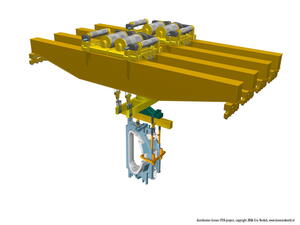Think big: The ITER bridge cranes
They will be big, very big: The two cranes that will one day help to assemble the main tokamak components such as the vacuum vessel segments and the toroidal coils to form the nine tokamak sectors, and subsequently to transfer the sub-assemblies to their final position in the tokamak building pit.
Some of these components and sub-assemblies are very heavy, therefore a twin crane system has been envisaged: the two cranes can work in pair for lifting loads up to 1500 tons, while at the same time having the flexibility to operate independently and thus increase assembly operations productivity for the majority of other lifts.
Technical characteristics and dimensions are impressive and almost unique, each crane's weight is estimated to be about 700 tons. Their longitudinal travel isapproximately 175 m on rails at an elevation of 40 metres. The main beams span about 47 m and roll on two trolleys, each one provided with a hoist of 375 tons capacity.
"Furthermore, the cranes have to be designed in order to withstand the design seismic event at full load without collapsing or releasing the load," explains Roberto Lanza, mechanical engineer and responsible for the cranes. Also, the cranes have to be capable of bridging the gap between the Assembly Hall and the Tokamak Building - the gap is 25 cm wide - which are separated for seismic reasons.
One of the challenges of these cranes will be the erection on site, which will be done by means of a high capacity crawler crane. "Another important issue is linked to the transportation, in fact cranes should be assembled and load tested at supplier workshop, disassembled and brought to site," Lanza points out. "In this scenario the bridge beams (47 m long, 2m wide, 4.5 m high) will be the most problematic item for transportation from the Etang de Berre to Cadarache, requiring some interventions to the planned route."
The signature of the Procurement Arrangement with the European Domestic Agency is planned for December this year, the crane installation should take place between December 2012 and February 2013.


